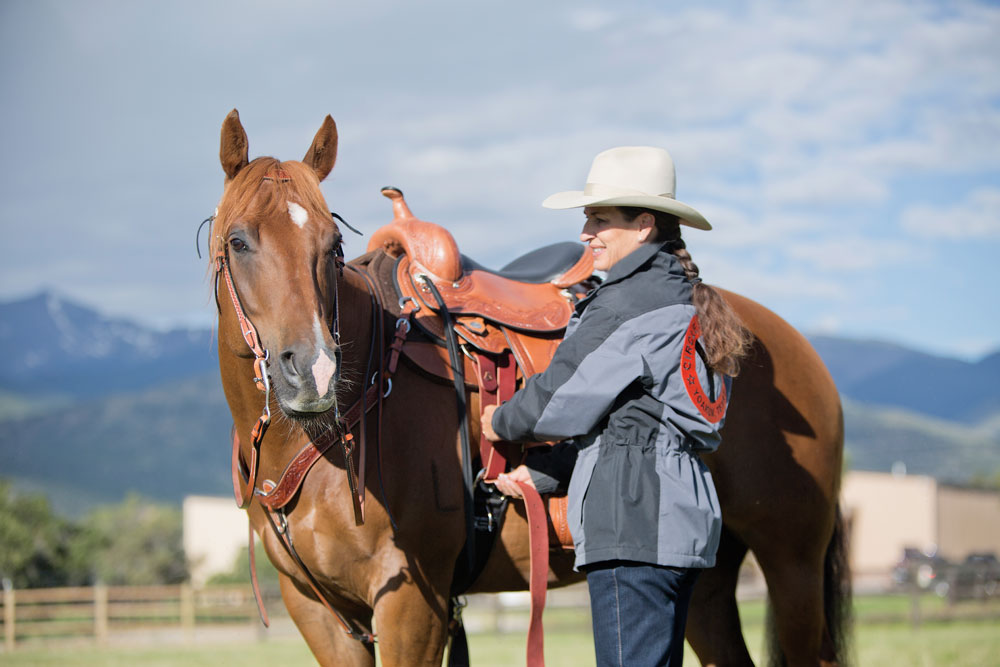Q: How snug should I make my horse’s cinch, and what is the right way to tighten it? I don’t want to hurt my horse and I want to make sure he never becomes cinchy.

The cinch needs to be tight enough to allow you to mount and dismount without the saddle shifting. You want to keep the saddle balanced, but you don’t want to tighten a cinch more than needed; that can be uncomfortable for the horse, and cause him to resist the saddling process.
A less experienced or out-of-balance rider may need a tighter cinch. A small rider who is unbalanced may not move the saddle that much, but an adult who is off balance can easily shift a saddle that is not adequately secured with the cinch. If you’re cutting cattle or running barrels, you want to make sure your saddle doesn’t shift as the horse performs tight turns.
The horse’s conformation also plays a role. Higher withers help keep a saddle in place. If you have a round horse with low withers, you may have to tighten the cinch quite a bit.
The type of pad and the material the cinch is made of can also affect how tightly you’ll need to cinch up. If the cinch material is smooth and slick, it won’t help the saddle stay in place.
Cinching Up
It’s best to untie your horse before tightening the cinch. He doesn’t have to be totally loose, but if he becomes uncomfortable during the process, you don’t want him to be tied hard and fast to a hitching rail or cross-ties. He could pull back and panic, which may lead to tying problems later on. Lay the lead over a rail so that he knows not to move, but perceives he is tied and will stand still.
I like to rub the horse’s girth area before I bring the cinch into place. With my head facing the horse’s head (to keep it out of the kick zone), I bend to reach for the cinch and attach the cinch with the buckle. At this point, I only attach the cinch enough so that the saddle will stay in place. Then I’ll move the cinch up one hole, wait a moment and cinch up one more hole. When I’ve bridled and am ready to get on, I walk the horse a minimum of five steps to allow the saddle to settle on to his back. Then I’ll tighten the cinch enough so that I can get on. If the saddle slips as I get on, it’s too loose. As the horse warms up, the tack will settle further onto his back. Check your cinch again 10 minutes into your ride, or before you canter.
Cinch Checkpoints
To check the cinch from the ground, reach between the horse’s front legs and check at the horse’s centerline. You should be able to put one index finger under the cinch to your finger’s first joint. If you can reach in at the back of the cinch more than that, it’s probably too loose. If you can’t fit a finger in at all, it may be too tight.
Checking the cinch behind the horse’s shoulder just below the saddle doesn’t give you a very accurate reading. Most horses are concave there, so the cinch will always feel loose in that spot.
Tightening Tip
Don’t expect your horse to always use the same hole on your cinch or latigo; it will change somewhat as he changes in age, fitness and hair coat. Go by what you notice and how it feels, not by counting the holes.
JULIE GOODNIGHT shares her lessons on her RFD-TV show, Horse Master (also online at tv.juliegoodnight.com), and through clinics and expos.
HEIDI MELOCCO (www.whole-picture.com) is a lifelong horsewoman, equine journalist, and photographer.
This article originally appeared in the March 2016 issue of Horse Illustrated magazine. Click here to subscribe!







[…] https://www.horseillustrated.com/western-horse-training-how-tight-should-my-cinch-be […]